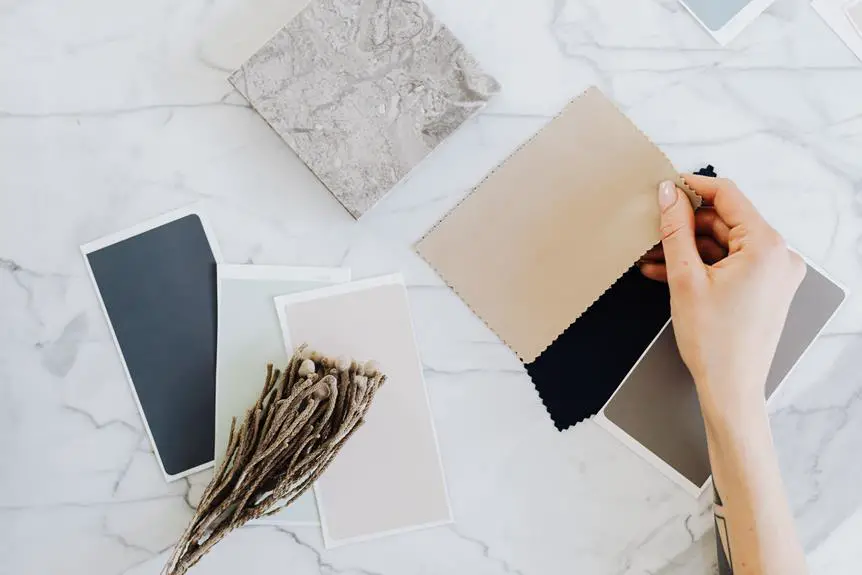When it comes to choosing the right fabric for your next project, navigating the myriad options can feel like walking through a maze.
Each fabric has its own unique qualities, making the decision a complex tapestry to unravel.
Understanding the attributes of cotton, silk, wool, linen, polyester, rayon, and denim is crucial in selecting the best material for your specific needs.
Let's explore the characteristics of each fabric to find the perfect match for your next creation.
Key Takeaways
- Cotton is a versatile and easy-to-care-for fabric that holds color well, making it a great choice for various projects.
- Silk is a luxurious fabric with a beautiful drape, making it suitable for formal wear.
- Wool is a warm and durable fabric that provides insulation and regulates body temperature.
- Polyester is a durable and wrinkle-resistant synthetic fabric that retains its shape and color, making it a practical choice for many projects.
Cotton
If you're considering using cotton for your next project, it offers a versatile and breathable option for a wide range of sewing and crafting endeavors.
Cotton is known for its breathability, making it an ideal choice for clothing items, bedding, and various household items. This natural fiber allows air to circulate, making it comfortable to wear in warm weather and suitable for those with sensitive skin.
Additionally, cotton is soft to the touch, providing a gentle and comfortable fabric for everyday use.
Furthermore, cotton is easy to care for, as it's machine washable and can withstand high temperatures, making it durable and long-lasting. Its ability to hold color well also ensures that cotton items remain vibrant and attractive even after multiple washes.
This makes cotton an excellent choice for a wide array of sewing projects, from garments and accessories to home decor items. Whether you're a seasoned crafter or just starting out, cotton's breathability, softness, and easy care make it a top choice for your next project.
Silk
Silk is a luxurious and versatile choice for your next project. It offers a wide range of options for various types of garments and home decor.
Understanding care and maintenance tips is essential to ensure the longevity of your silk fabric.
Luxurious and Versatile Choice
When choosing fabric for your next project, consider using silk for its luxurious and versatile qualities. Silk is renowned for its soft, smooth texture and natural sheen, making it a popular choice for elegant and high-end garments. It drapes beautifully, lending a graceful and flowing quality to clothing.
Additionally, silk is a versatile fabric, suitable for a wide range of projects including formal wear, lingerie, and scarves. Despite its luxurious appeal, silk can also be a sustainable option when sourced responsibly. Ethical silk production methods and eco-friendly dyeing processes can minimize its environmental impact.
Care and Maintenance Tips
For proper care and maintenance of silk, follow these simple guidelines to preserve its luxurious qualities:
- Hand Washing: Gently hand wash silk in cold water using a mild detergent to avoid damage to the delicate fibers.
- Drying: Lay the silk flat on a clean towel and roll it up to absorb excess water, then reshape and air dry away from direct sunlight to prevent fading.
- Ironing: Iron silk on a low setting while it's still slightly damp or use a pressing cloth to avoid leaving shiny marks on the fabric.
- Stain Removal Techniques: Address stains promptly by dabbing with a soft cloth and mild soap, or use specialized silk stain removers for tougher stains.
- Storage: Store silk garments in a breathable cotton garment bag to protect from dust and avoid exposure to sunlight to prevent color fading.
Wool
You can't go wrong with wool for your next project if you want a durable and versatile fabric. Wool is renowned for its warmth and insulation properties, making it an excellent choice for cold-weather garments and accessories.
The natural crimp in wool fibers creates insulating air spaces, which help to regulate body temperature, keeping you warm in the winter and cool in the summer. Additionally, wool is a sustainable and eco-friendly fiber. It's biodegradable and renewable, as sheep produce new fleece annually. The production of wool also has a lower environmental impact compared to synthetic fibers, contributing to its eco-friendly reputation.
Wool is a resilient and long-lasting fabric, capable of withstanding heavy wear and tear. Its natural elasticity allows it to retain its shape and resist wrinkles, making it suitable for various types of projects, from cozy blankets to durable outerwear. When cared for properly, wool can last for many years, making it a worthwhile investment for your crafting endeavors.
Whether you're a seasoned crafter or a beginner, wool's versatility and durability make it a top choice for a wide range of projects.
Linen
Linen's breathability and natural luster make it a versatile choice for crafting projects, complementing wool's durability and insulation properties. When considering linen for your next project, keep in mind its benefits:
- Breathability: Linen fabric allows air to flow through, keeping you cool and comfortable, making it perfect for warm-weather garments.
- Moisture-wicking: It absorbs moisture quickly, keeping you dry and preventing bacteria growth.
- Versatility: Linen's natural texture and drape make it suitable for a wide range of projects, from clothing to home decor.
- Durability: While not as insulating as wool, linen is exceptionally strong and long-lasting, making it a great choice for items that will see frequent use.
- Eco-friendly: Linen is biodegradable and requires less water and pesticides to grow compared to other fabrics, making it a sustainable option.
If you're considering alternatives to linen, you may explore fabrics like cotton, hemp, or bamboo, each with its own unique properties. When choosing a fabric for your next project, consider the specific qualities and benefits that linen offers, and how they align with your project's needs.
Polyester
When considering fabric options for your next project, polyester is worth considering due to its durability and wrinkle-resistant nature.
Additionally, polyester is quick-drying and requires minimal maintenance, making it a practical choice for various applications.
These attributes make polyester a versatile and reliable fabric choice for a wide range of projects.
Durable and Wrinkle-Resistant
For your next project, consider using polyester fabric for its durability and wrinkle resistance. Polyester is an excellent choice for those seeking durable fabrics that are easy to care for. Here are five reasons why polyester is ideal for your next project:
- Polyester fabric is highly resistant to wrinkles, making it perfect for clothing that needs to maintain a crisp, professional look.
- It's a long-lasting material that can withstand frequent washing and wear without losing its shape or color.
- Polyester is a low-maintenance fabric, requiring minimal ironing and maintaining its appearance even after multiple washes.
- This fabric is ideal for upholstery and home decor projects, as it can withstand daily use and is easy to clean.
- Polyester's durability makes it a great choice for outdoor and active wear, as it can endure rigorous activities and frequent washing.
Quick-Drying and Low-Maintenance
If you're looking for a fabric that offers quick-drying and low-maintenance properties, polyester is an ideal choice. Its durability and wrinkle resistance make it a practical option for a wide range of projects.
Polyester fabric is known for its exceptional moisture-wicking performance, making it a great choice for activewear, outdoor gear, and other applications where moisture management is crucial. Its quick-drying nature ensures that it dries rapidly after washing or exposure to moisture, making it convenient for travel-friendly fabrics.
Polyester's low-maintenance characteristics also make it a popular choice for busy individuals who want garments and textiles that are easy to care for. These qualities make polyester a reliable option for those seeking practical and efficient fabric choices.
Rayon
Consider rayon for its versatility and affordability when planning your next sewing project. Rayon is a soft, breathable fabric that offers a wide range of benefits for your creations. Here are five reasons why rayon could be the perfect choice for your next project:
- Versatility: Rayon is a highly versatile fabric that can mimic the feel and texture of natural fibers like silk and cotton, making it suitable for a variety of garment types, from flowing dresses to tailored shirts.
- Breathable: Its breathable nature makes it ideal for warm-weather clothing, ensuring comfort and ease of wear, even on the hottest days.
- Affordability: Rayon offers a cost-effective alternative to pricier fabrics, allowing you to create high-quality garments without breaking the bank.
- Drape: Rayon has excellent drape, making it a popular choice for creating elegant, flowing silhouettes in garments.
- Easy care: Rayon is generally easy to care for, requiring minimal maintenance and making it a practical choice for everyday clothing.
Denim
Why should you choose denim for your next sewing project?
Denim is a versatile and durable fabric that has been a staple in fashion for decades. Its sturdiness and classic look make it a popular choice for a wide range of garments, from jeans and jackets to skirts and bags.
If you're considering denim alternatives, sustainable options like organic cotton denim or recycled denim are worth exploring. These eco-friendly choices reduce the environmental impact of denim production and contribute to a more sustainable fashion industry.
When it comes to denim dyeing methods, it's important to consider the environmental impact. Traditional indigo dyeing processes can be harmful to the environment due to the chemicals involved and the water usage. However, advancements in technology have led to more eco-friendly dyeing methods, such as using plant-based or low-impact dyes, and implementing water recycling systems. These sustainable practices aim to minimize the environmental footprint of denim production while still achieving the desired indigo hues.
Frequently Asked Questions
How Can I Best Care for My Fabric to Ensure It Lasts a Long Time?
To care for your fabric and ensure longevity, consider eco-friendly options and compatibility with your specific project. Follow care instructions, store properly, and avoid harsh chemicals. Regularly assess and address any fabric-specific considerations.
Are There Any Specific Environmental or Ethical Considerations to Keep in Mind When Choosing a Fabric?
When choosing fabric, consider its environmental impact and ensure ethical sourcing. Look for eco-friendly materials like organic cotton, linen, or bamboo. Check for certifications like GOTS or OEKO-TEX to ensure sustainable and ethical production.
Can I Mix Different Types of Fabrics in One Project, and if So, Are There Any Special Considerations I Should Be Aware Of?
Yes, you can mix different types of fabrics in one project, but be aware of their care requirements and consider their longevity. Pay attention to the weight, drape, and compatibility of the fabrics for a cohesive outcome.
What Are Some Common Misconceptions or Myths About the Fabric That I Should Be Aware Of?
Fabric misconceptions and durability are important to consider. Ethical sourcing and environmental impact also play a role. Understanding these aspects will help you make informed decisions when choosing fabric for your projects.
Are There Any Special Considerations for Working With These Fabrics in Specific Types of Projects, Such as Apparel Versus Home Decor?
When working with delicate fabrics, consider the specific project type. For apparel, prioritize flexibility and breathability. For home decor, opt for durability and easy maintenance. Choose the right fabric based on the unique needs of your project.
- Can You Get Organza Wet? - April 23, 2024
- Why Is Organza so Popular? - April 23, 2024
- What Do You Wear With Organza? - April 23, 2024





